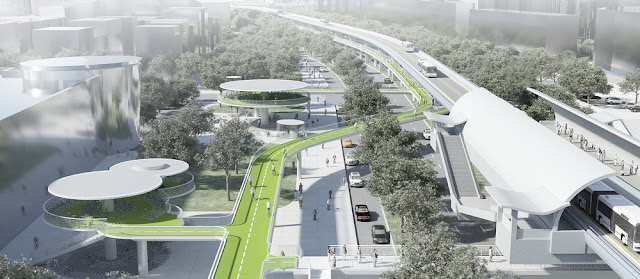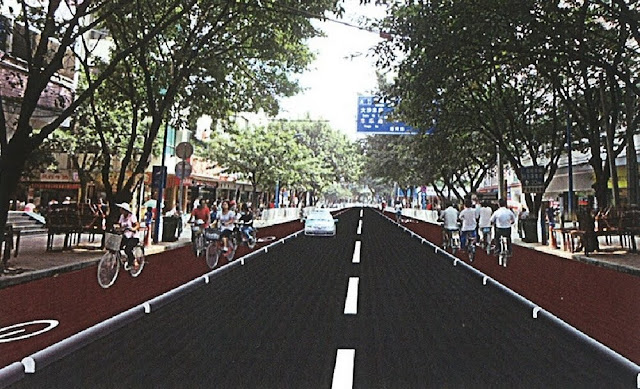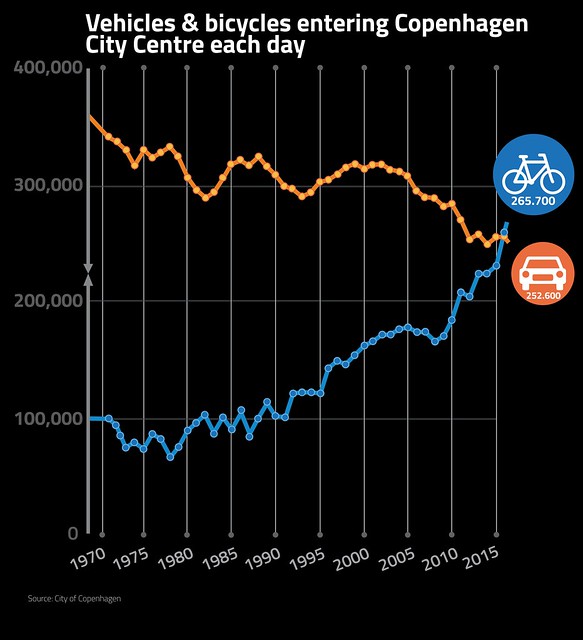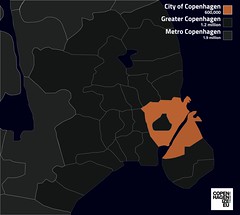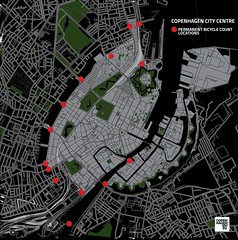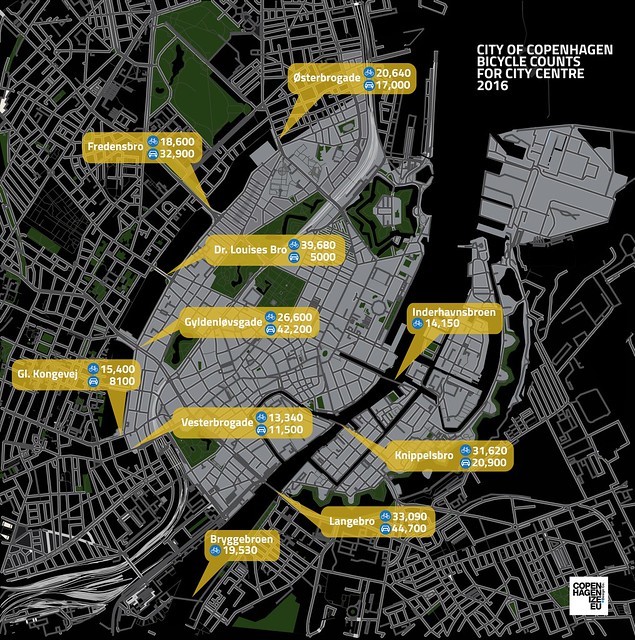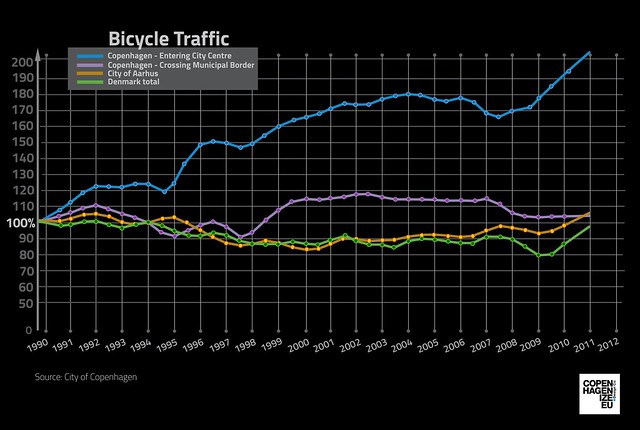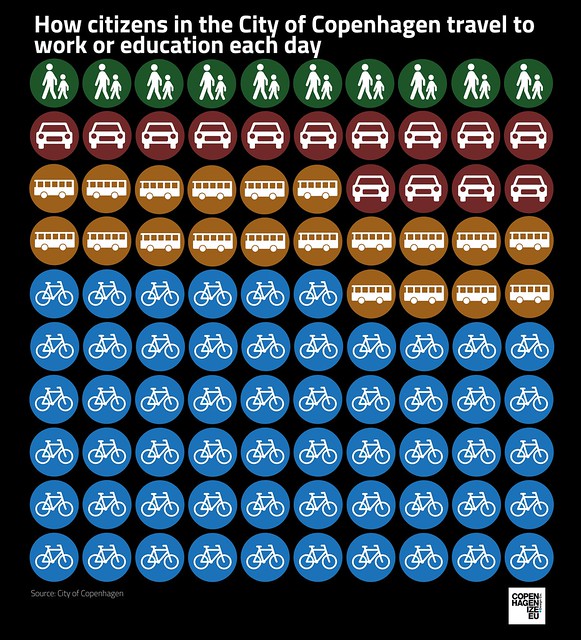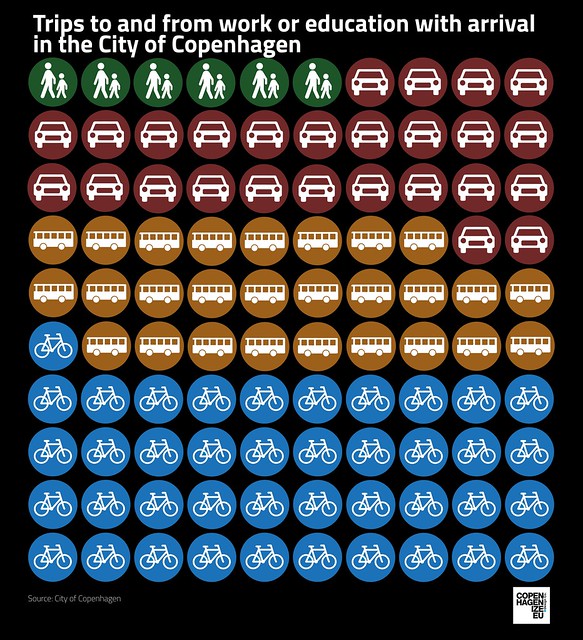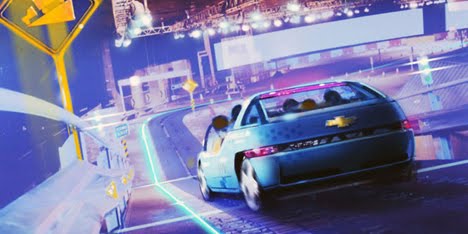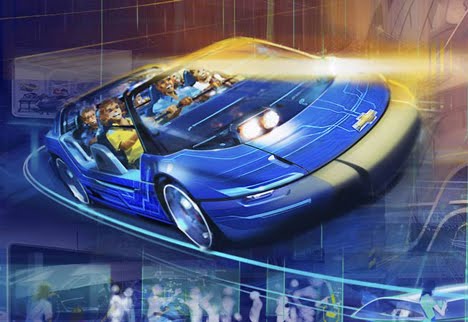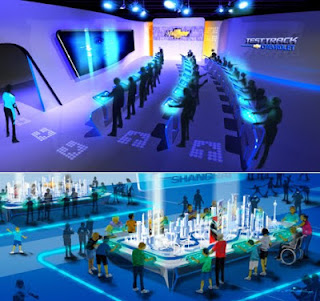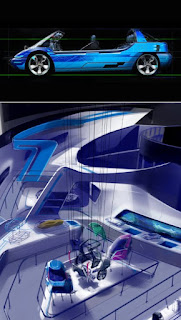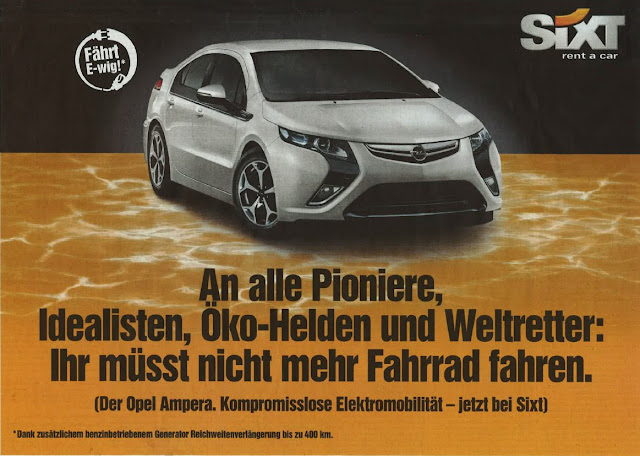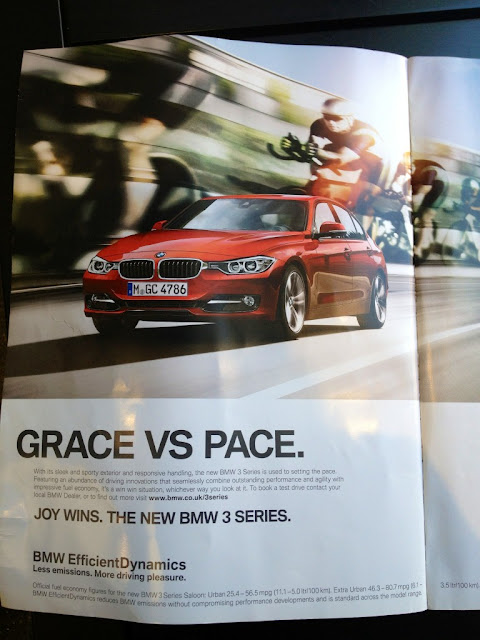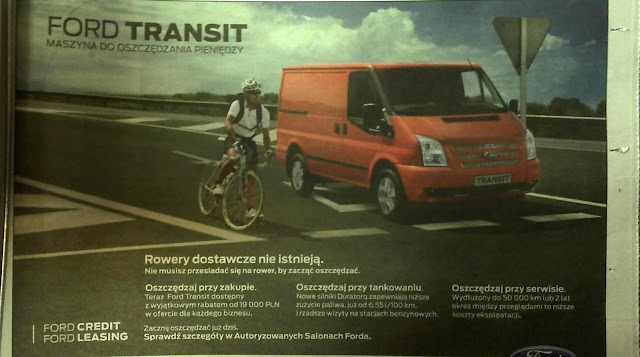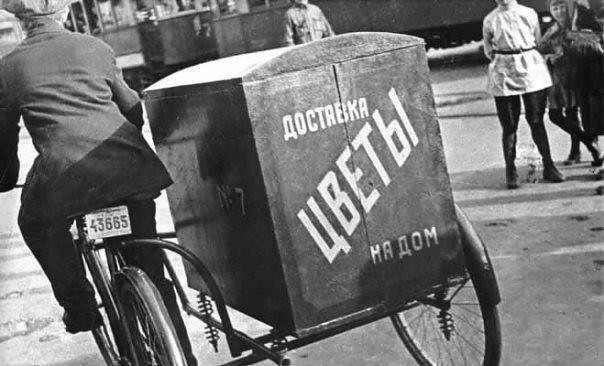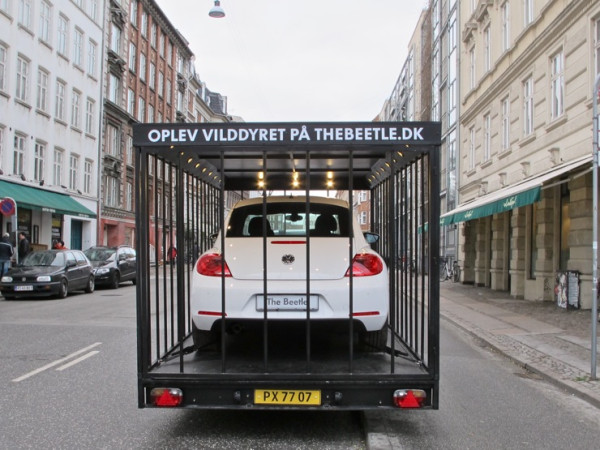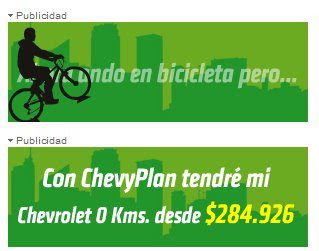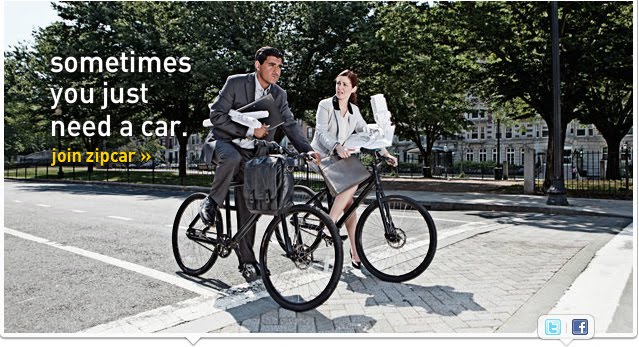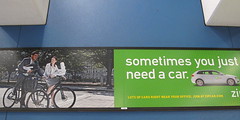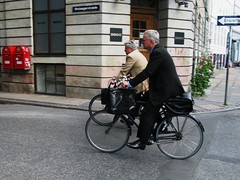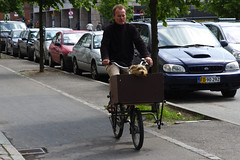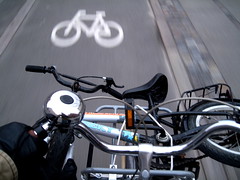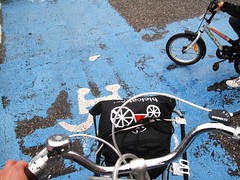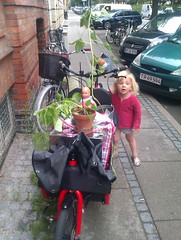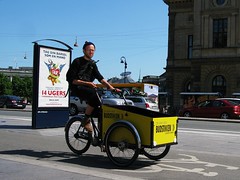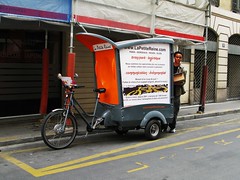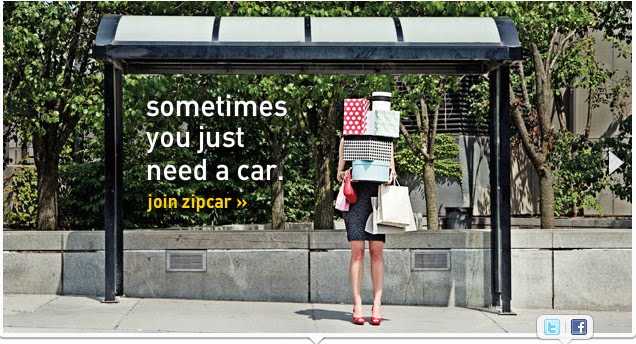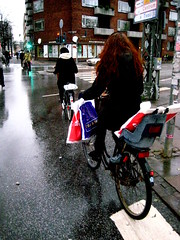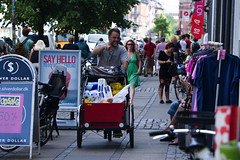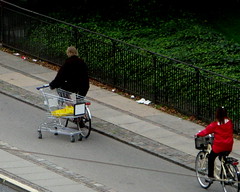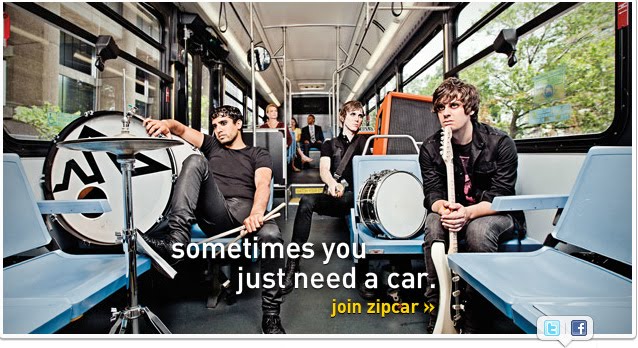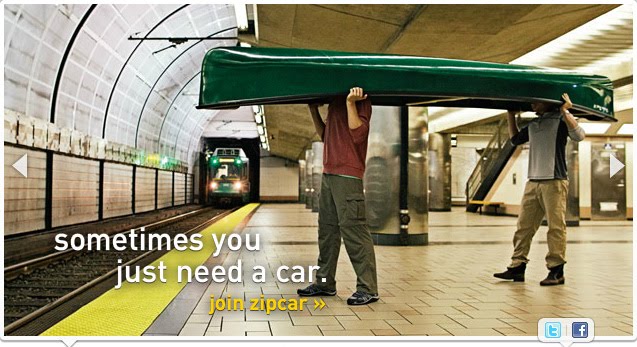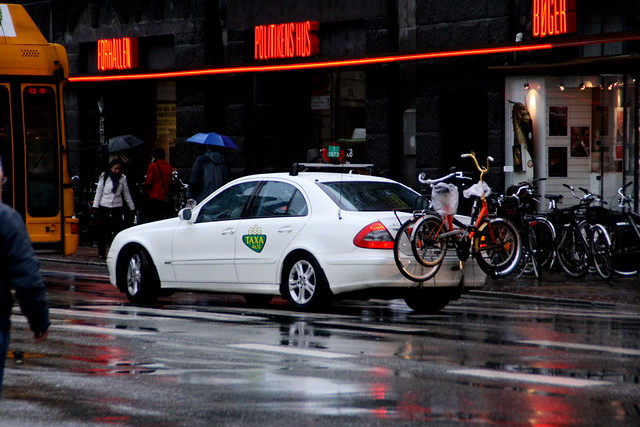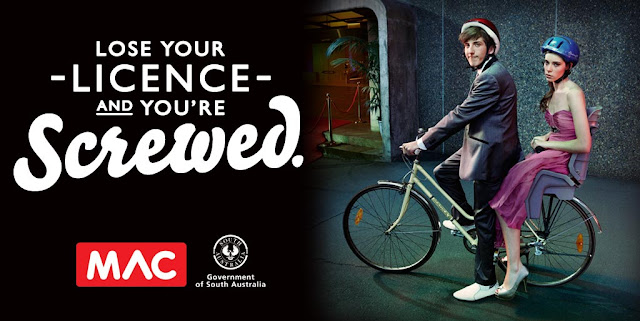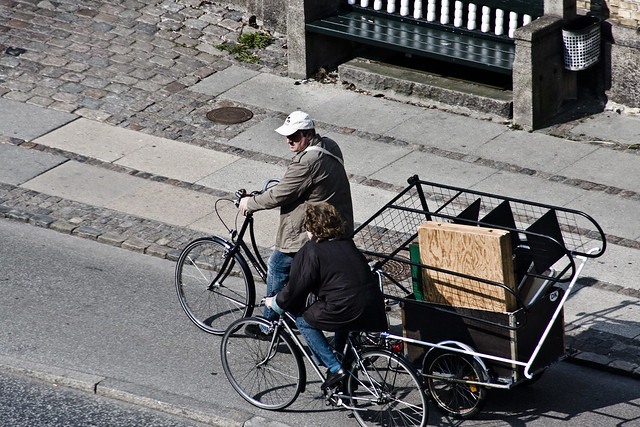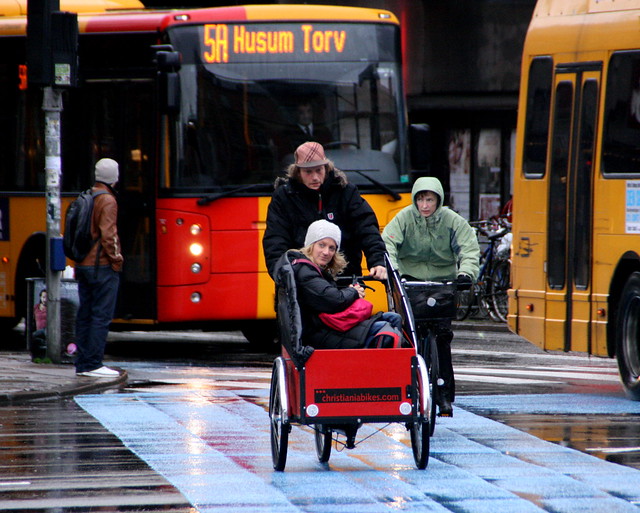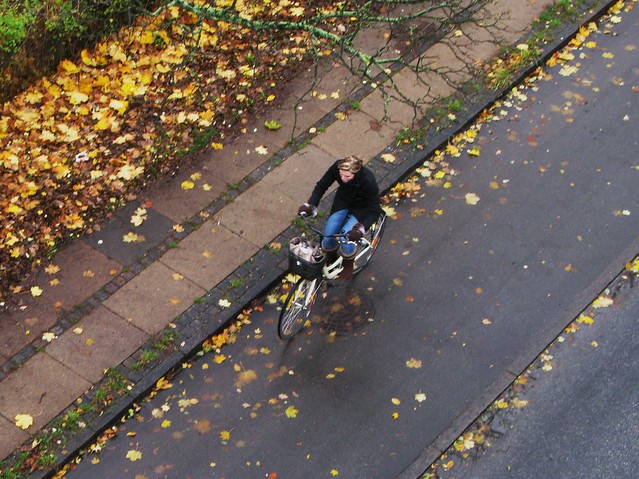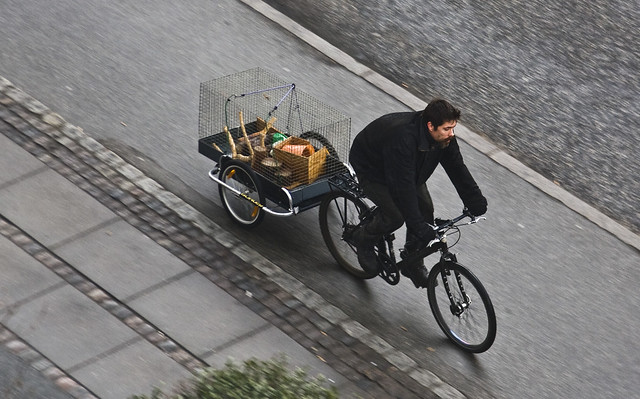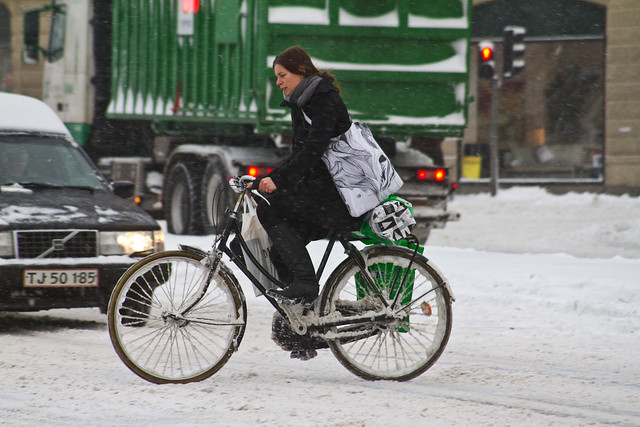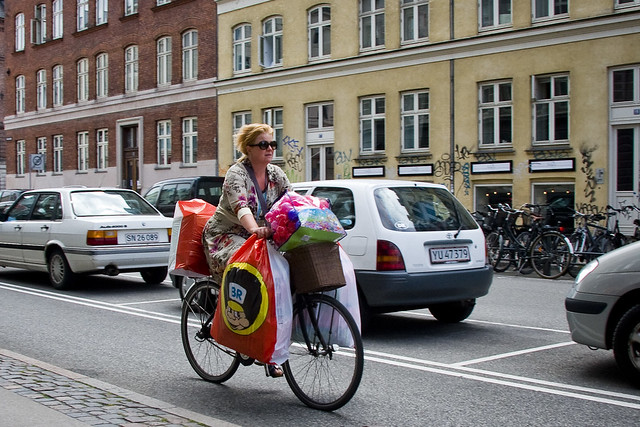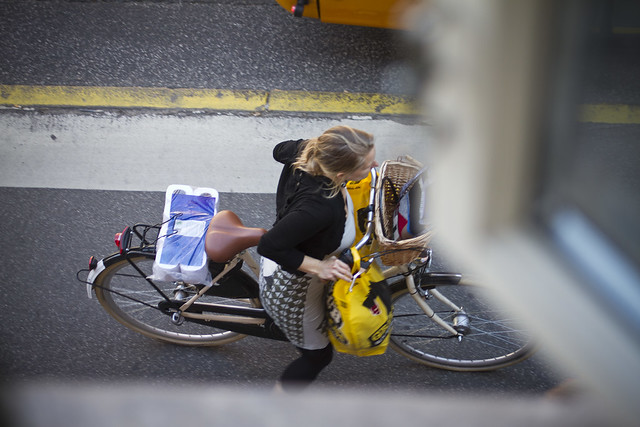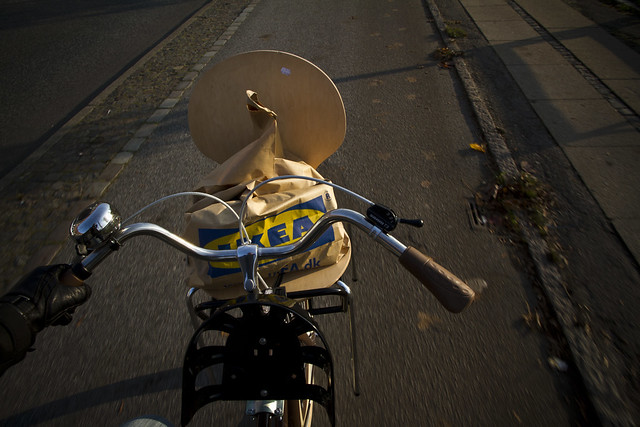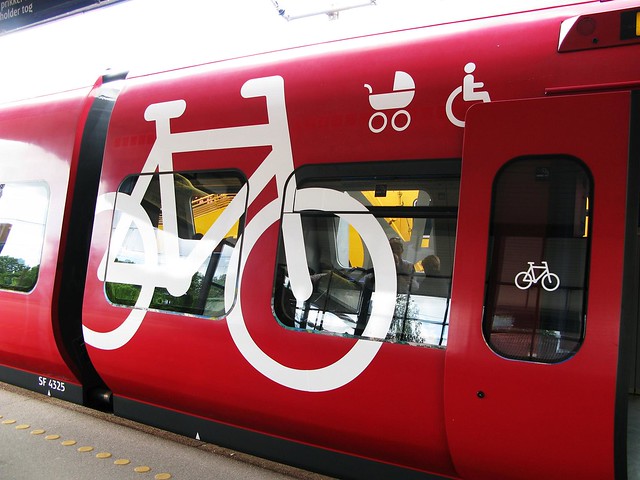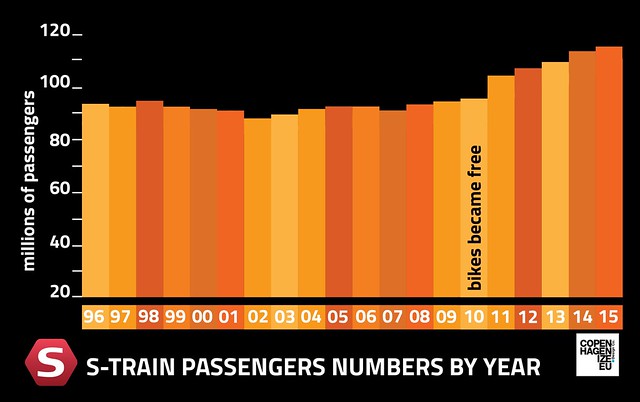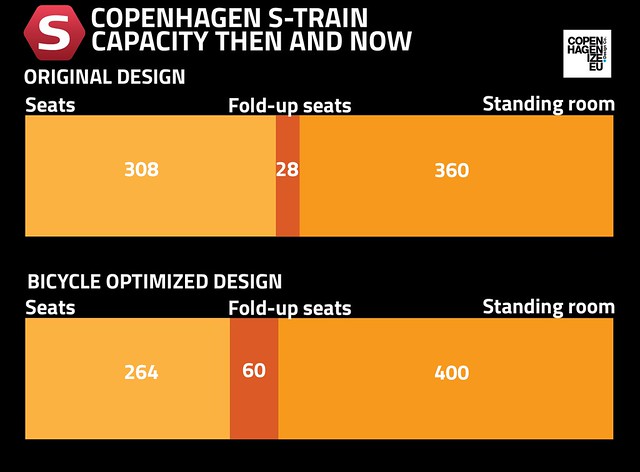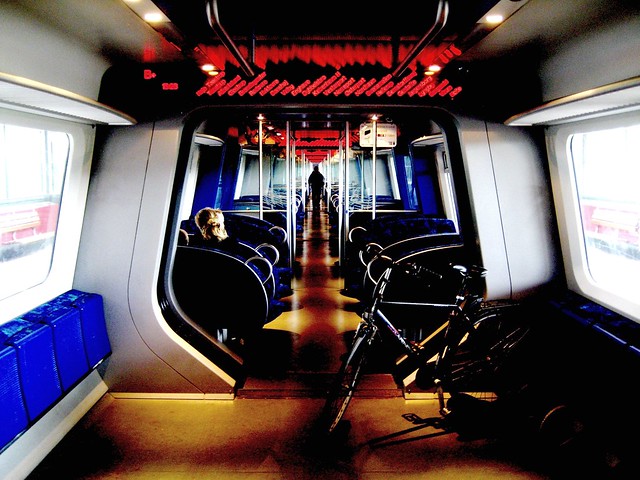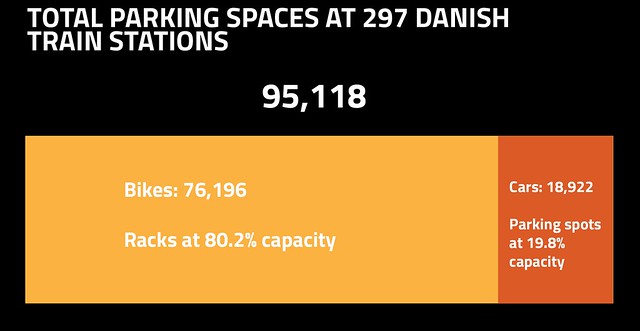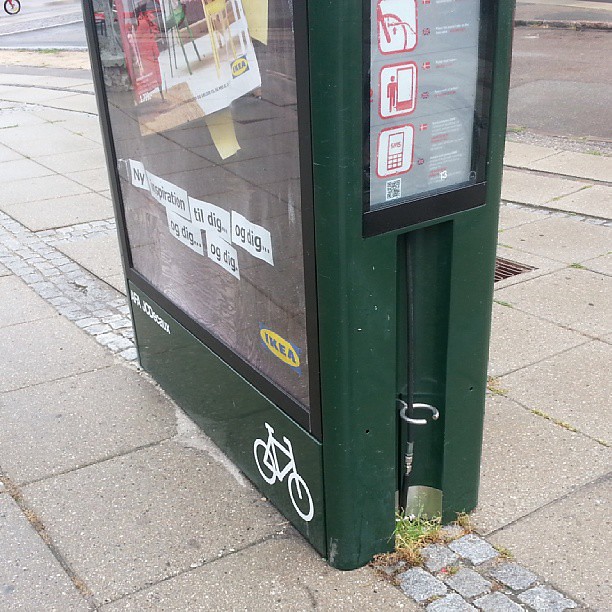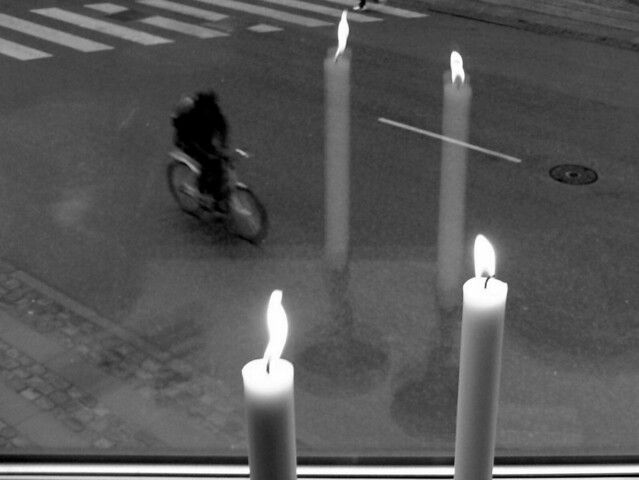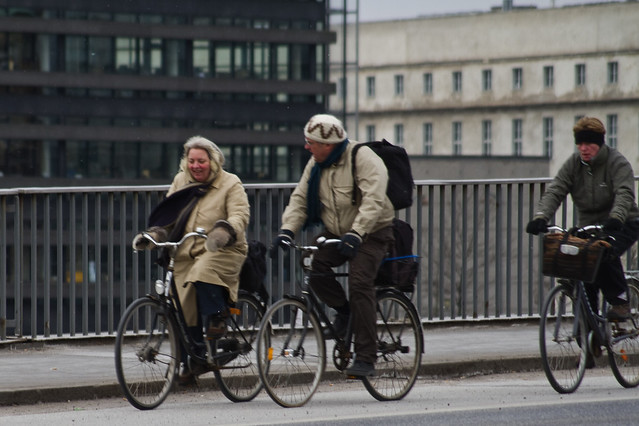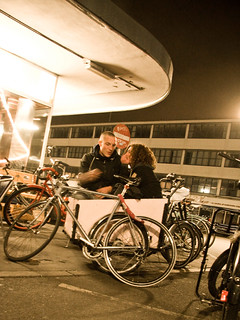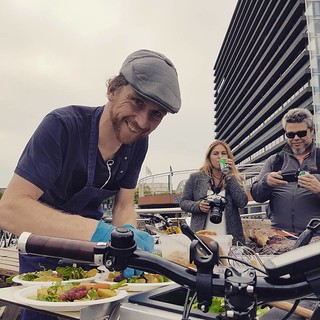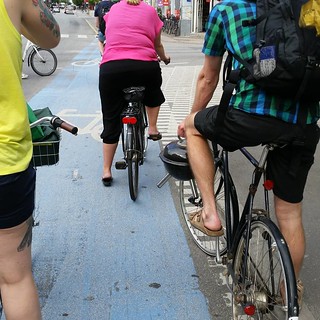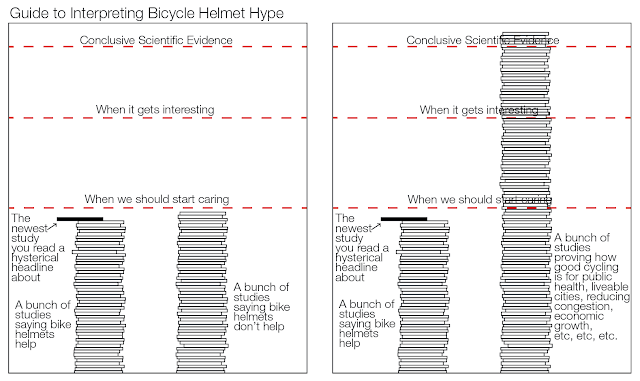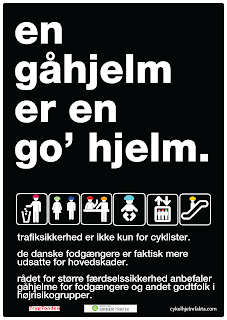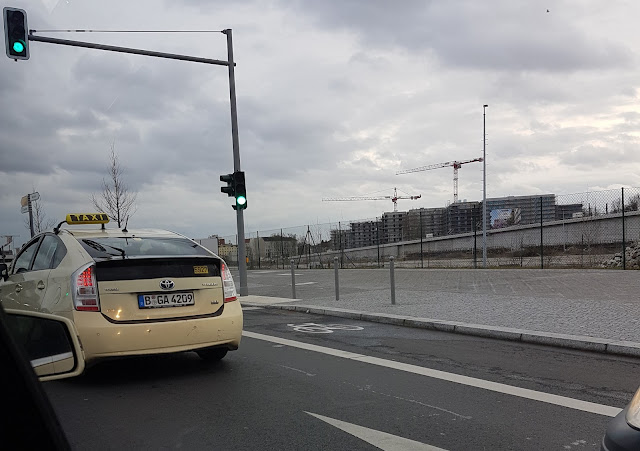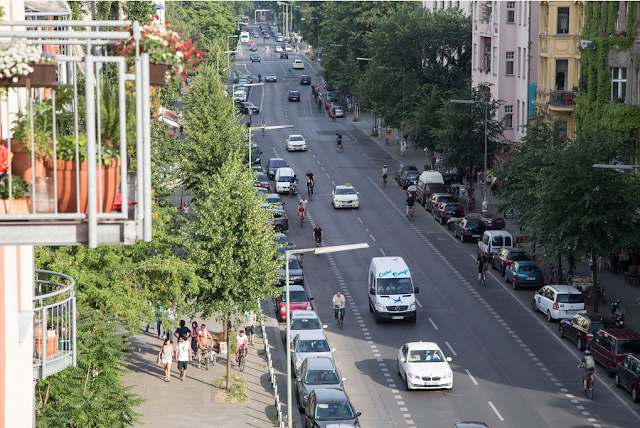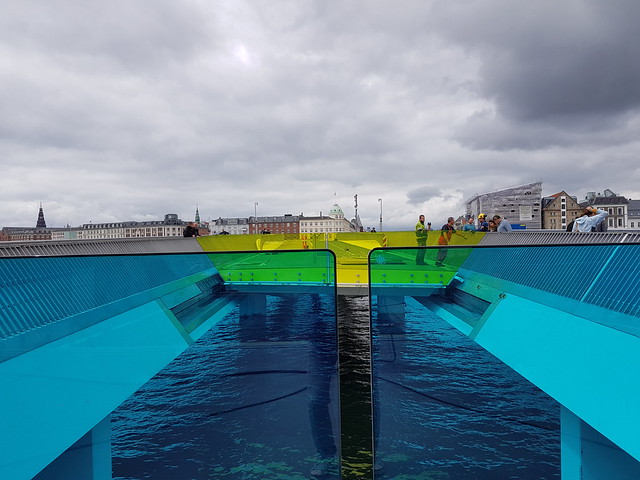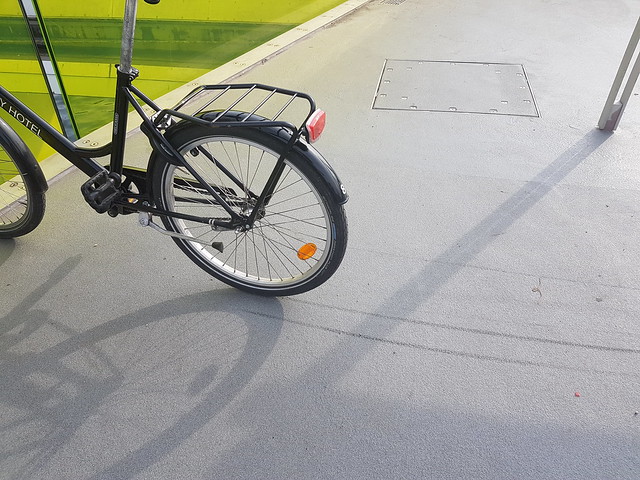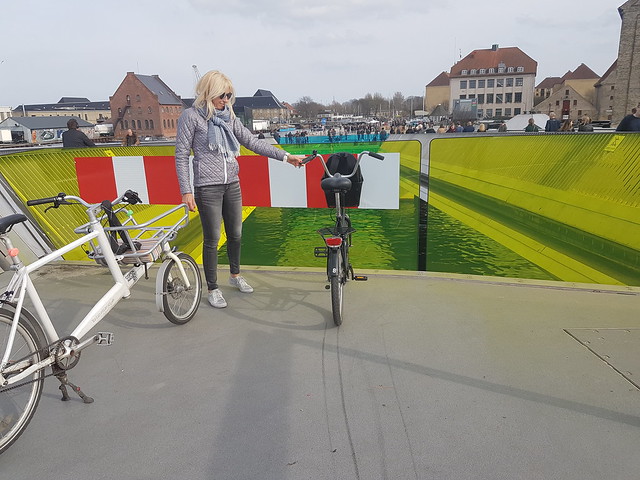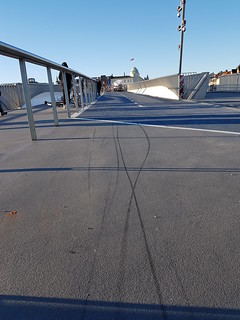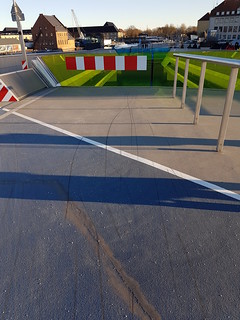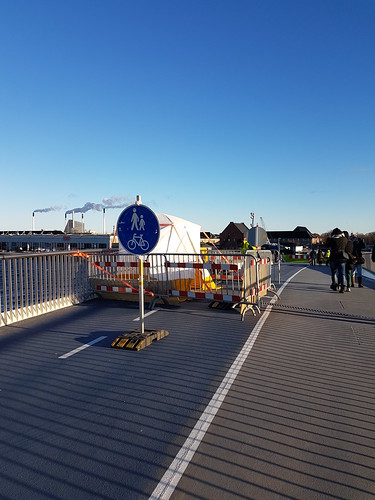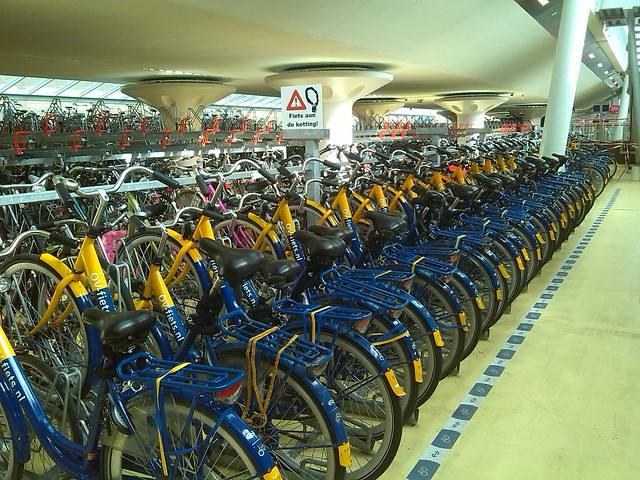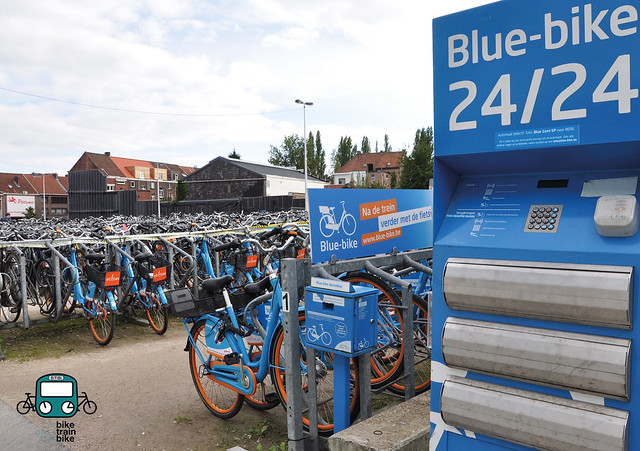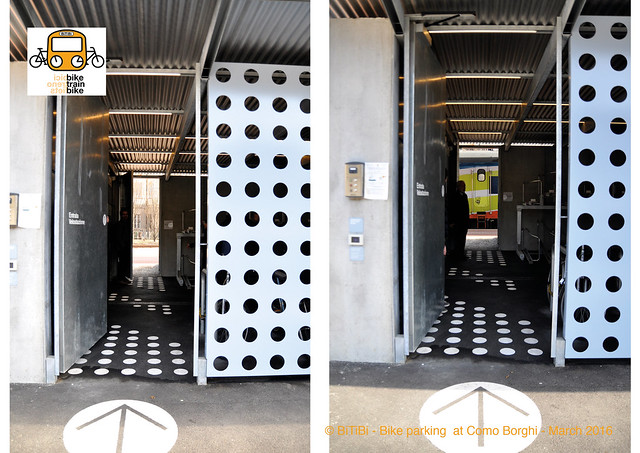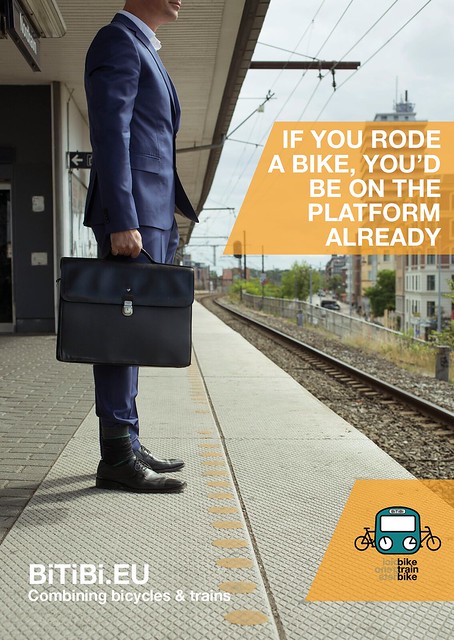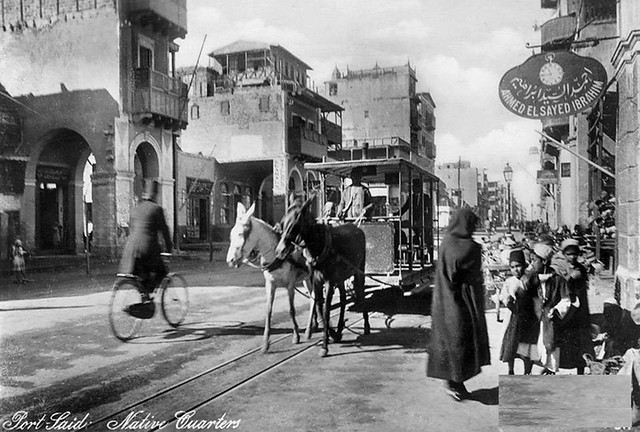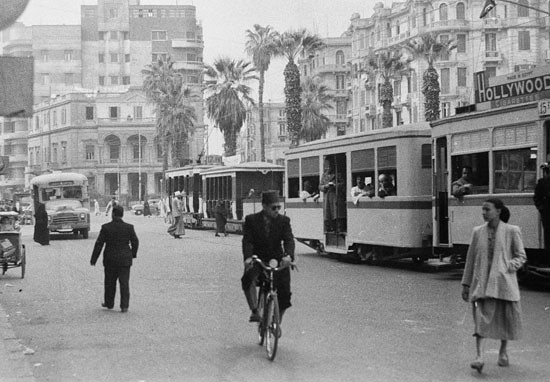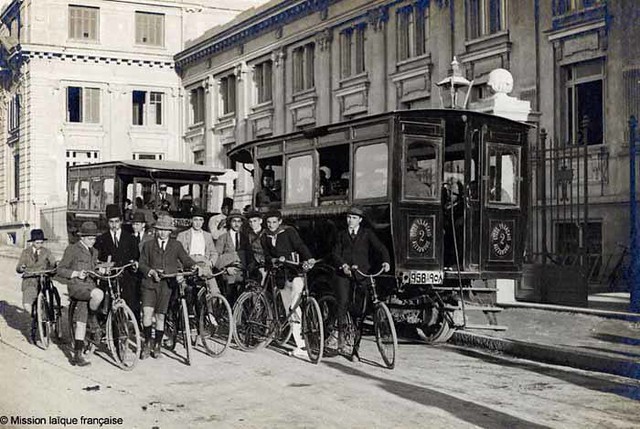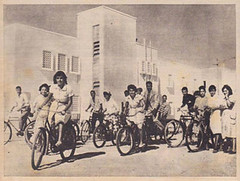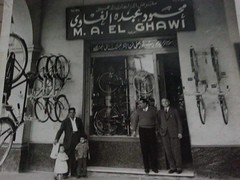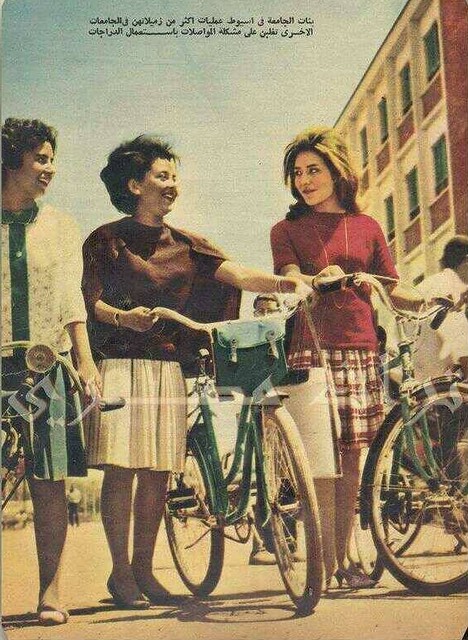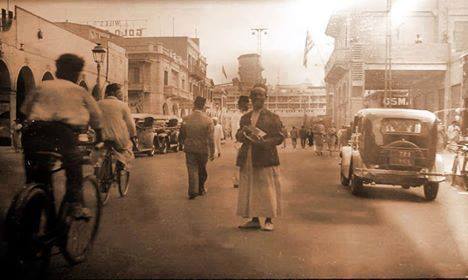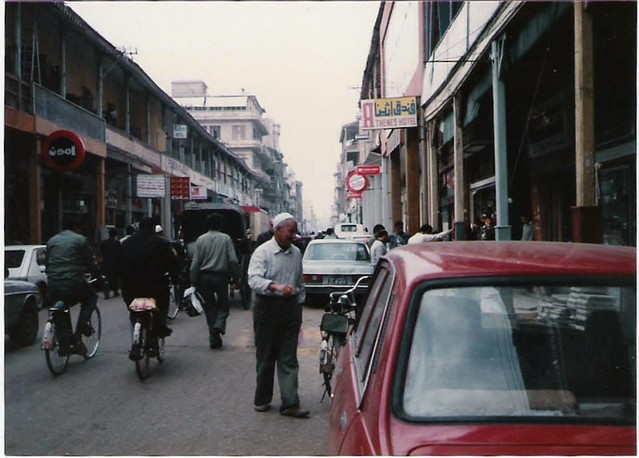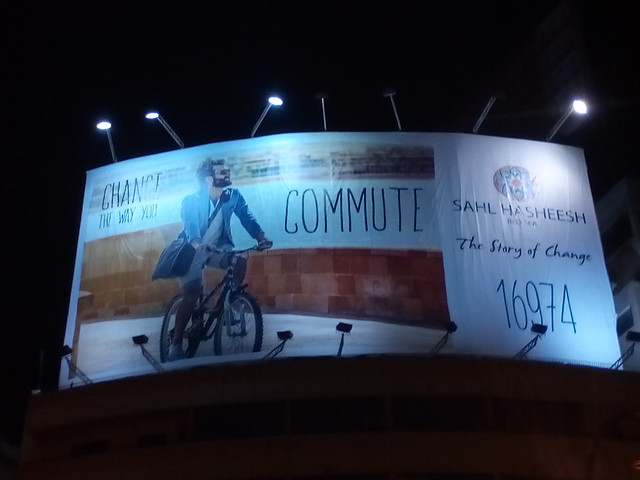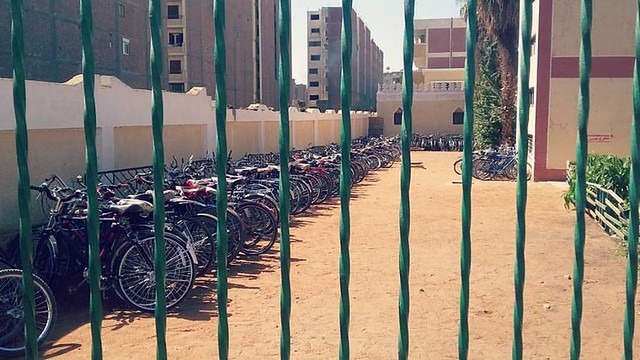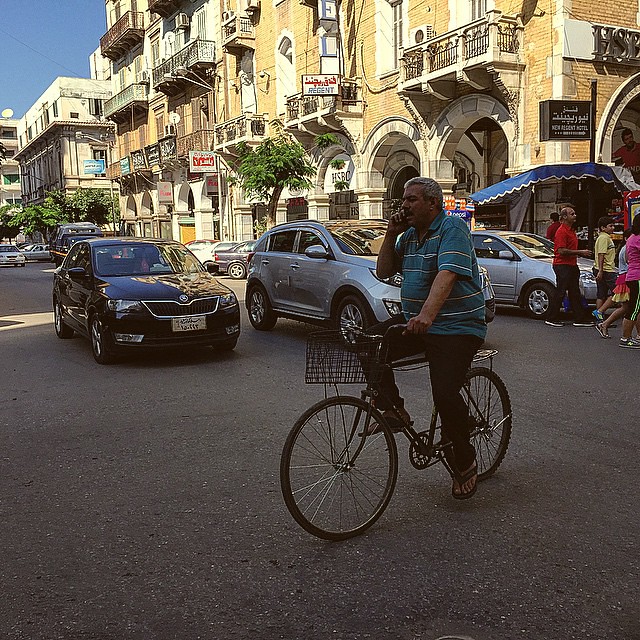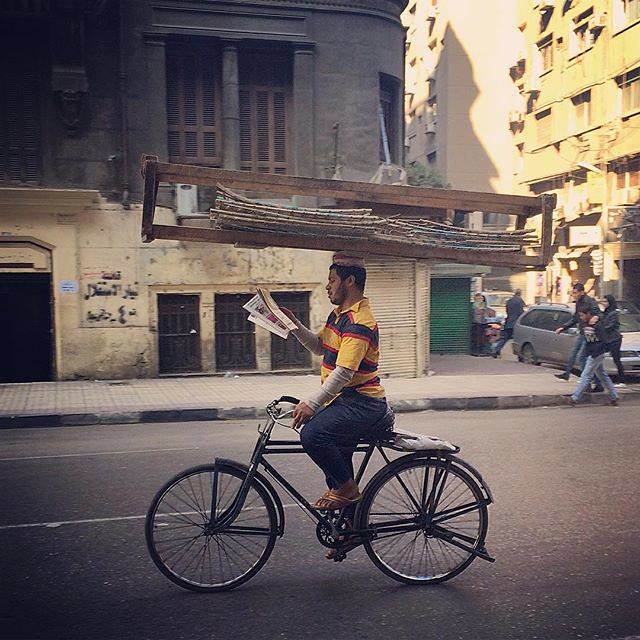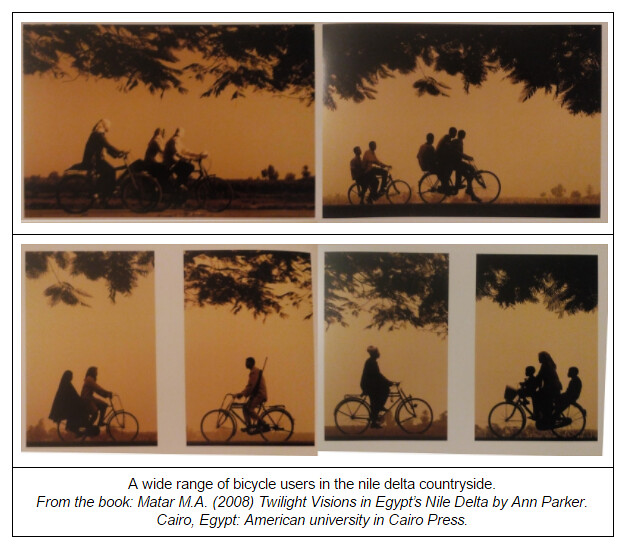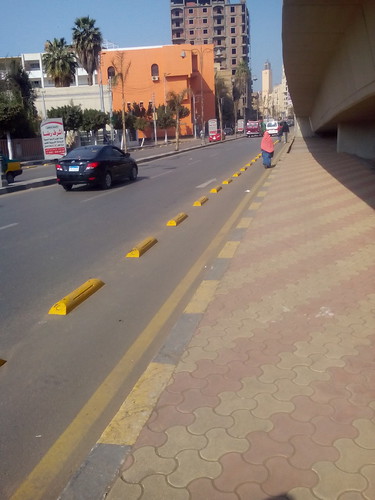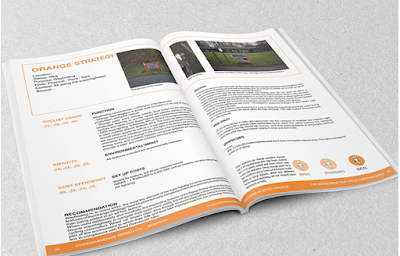We've been compiling a list of examples of how the automobile industry, since the bicycle returned to the public consciousness around 2006-2007, have been striking back. Using their advertising millions to ridicule not just bikes but public transport. It is the surest sign that they feel threatened by the return of serious competition. So threatened that they actively spend money on tackling it.
A few years ago we made a commercial -
If Car Commercials Were Based on Fact, Not Fiction.
Citroen did not like it at all and here's THAT fun story.Here is a long list of examples of The Car Empire Strikes Back - dating from 2009 here on the blog. We'll add new ones here as they appear. And they will.
FORD - NOVEMBER 2016Does he deserve the new Ford Mondeo? Oh yes. He does. He had to ride an elevator with a smelly, sub-cultural cyclist dude. So of course, he does.
Amusingly, here's the opposite side of the coin. A commercial from the Dutch TV and Film School. Smug motorists in an elevator. Announcement says first, "Attention, the blue Saab is being towed." Then followed by, "Attention, the yellow Lotus is rolling towards the Saab". Or something like that. Cue smug cyclist.
VOLVO - MARCH 2015The latest piece in our ongoing series writes itself. This time it's Volvo doing its best to draw your attention to the fact that motorists kill obscene amounts of people - including themselves - by placing the responsibility on cyclists and pedestrians. It's a smoke screen and this time it's sprayed on. It is
Ignoring the Bull in Society's China Shop taken to the next level.
Volvo Life Paint. Seriously. Life paint.
But hey... it's not for the 35,000+ people killed by or in cars in the EU alone by Volvo and their Big Auto homies (around the same in the US and 1.2 million worldwide - not to mention the tenfold more killed by pollution from cars and trucks or the hundreds and hundreds of thousands more injured...).
And no, it's not
rational ideas like helmets for motorists or making motorists responsible by
forcing them to have external airbags.
It's spray on paint.
No, not for cars, even though
black cars are most likely to be involved in collisions. No, it's not rational stuff like reflective paint on cars or
health warning legislation on all automobiles.
It's for you on foot or on a bicycle because you are an irritation to motorists. You are a squishy bug ruining their paint job. You are a threat to their mobility dominance. You must be ridiculed with calls for reflective vests/clothing and
a variety of ways to hate on pedestrians. Now you have the gift of Big Auto paint to spray on your irritating person.
http://www.volvocarslifepaint.com/I don't think we realise how slippery a slope it is we are on as a society when morons like this produce crap like this and actually get taken seriously.
Fortunately,
we have a better idea for Volvo. Make Life Shine.SMART - SEPTEMBER 2014Yep. All this growing momemtum for liveable cities and civilised streets after almost a century of destructive, car-centric traffic engineering is really starting to irritate Big Auto. Smart is no exception. In an almost laughable direct extention of
the automobile industry's invention of the concept of jaywalking (as highlighted in this TED talk), Smart decided to use "fun" and "gameification" in order to keep the sheep that are pedestrians down. Under the thumb. Under control. In the name, of course, of their kind of safety. They call it:
![]()
They are really grasping at straws, Big Auto. This generation is abandoning the automobile and so here comes the spin... new, smart generation... for loving the city. Those of us who love cities rarely have a love of the automobile. We're tired of death, injury, destruction. The new smart generation can see through Big Auto's attempts to spin things their way once again. "To hook them back to the car"
as this former head designer at BMW actually told the crowd during his keynote.
So, funny dancing crossing lights to keep pedestrians "safe". Give me a break. 30 km/h zones like in over 120 European cities keep pedestrians and cyclists safe. Traffic calming does, too.
External airbags on cars - placing the responsability on the potential murderers, too. Reducing the number of cars in cities is a no-brainer for the new, smart generation. Eliminating car ownership in cities altogether
is actually a thing.
We who are new, smart and of this generation don't buy this blatant
ignoring the bull. The paradigm is shifting. We are rejecting the car-centric streets that we inherited from the past century. Let the pedestrians dance wherever the hell they like in
the Life-Sized City. It's the future of cities. It's back to the future, too. Seven thousand years of liveable cities will NOT be ruined by 90 odd years of deadly mistakes by traffic engineers and Big Auto, who have more deaths on their conscience that most dictators. The liveable city is rising once again, carried on the shoulders of a new, smart generation.
NISSAN - FEBRUARY 2014Car companies are now intent on ridiculing other transport forms or lathering themselves up in a greenwashing frenzy.
It's usually a roll-your-eyes, comical experience. Nissan Denmark, however, have outdone themselves. They're banging the drums for their new Qashqai model here in Denmark. It started last year on September 4, 2013 when Nissan hosted a "café" in the centre of Copenhagen, letting people take the Qashqai for a test drive. In the middle of the day. In the City of Cyclists and near our many pedestrian streets and a main metro station.
Kieran Toms, who is interning with Copenhagenize Design Co. at the moment, reported from the front lines. He popped into the "café" with a friend. Kieran, being a modern young man from the UK, doesn't have a driving licence, but his friend took Nissan up on the offer of a test drive. The Nissanite who accompained him extoled the virtues of the car and especially the acceleration. Unfortuntely, they were paralysed in traffic - while hundreds and hundreds of bicycle users rolled part, oblivious to the wonders of last century mobility. Acceleration consisted of crawling ten metres at a time down the streets. Involuntary humour from Nissan.
Now Nissan are ramping up their campaign for their car. The film, above, starts with the classic car industry shot of a car alone on a road - like THAT ever happens in a city. The text fades in declaring the Qashqui to be The Ultimate Urban Experience. Which, in reality in Copenhagen, is staring out the window at the rear end of some other car whilst citizens ride bicycles or walk past you.
Then they declare they're "Unlocking Copenhagen" for a weekend in March and they've enlisted a minor Danish celebrity Mads Christensen (self-proclaimed biggest braggart in Denmark). He tells us that he'll be the keymaster for unlocking the city, driving around in a Qashqai and challenging the city. Something about all your questions will be answered as they "zig-zag" around the city in March. Totally vague.
The film features clips of Copenhagen, including loads of people riding their bicycles, unaffected by Nissan's marketing prowess. Yeah. Whatever. Remember to wave or ring your bell at Nissan and the Braggart when you see them stuck in traffic on the weekend of March 6-8, 2014. Compared to the other examples of Car Industry Strikes Back, this one is hilarious and rather lame.
MERCEDES - MAY 2013Another day, another installment in
our Car Industry Strikes Back series wherein the automobile industry, in their own quirky way, do what they can to ridicule the competition, be it bicycles or public transport.
This Mercedes commercial is - by car industry standards - just plain goofy. Let it be a sign that they're slipping up and getting a bit desperate. Two pro drivers, Lewis Hamilton and Nico Rosberg, are cast in the roles of pro drivers who will never have careers as actors. The payoff at the end is classic Car Empire Strikes Back.
SMART - MAY 2013Another fine example wherein we observe the desperate tactics of the car industry as they try to respond to rising cycling levels and public transport in their vain attempt to keep their dominant market share in this age of
de-motorization.
This time it's Smart going for gold in this Portuguese commercial. Presenting us with worst-case scenarios from public transport and then having a young, hip-looking-ish man looking out the window at a Smart car rolling past - on an empty street at night. No traffic jams, nothing. Always amusing to see how car commercials try to get around showing traffic.
The tagline is SmartforTwo Public Transport. So now they're muscling in on the phrase Public Transport.
AUDI - DECEMBER 2012Ahh. That most desperate of car brands, Audi. I think they are the car brand we've featured most in this series. They're at it again, this time in Finland.
It ends with the money shot, of course. The car in question flying along a road without any traffic. Free as a bird and at extremely high speeds. Everything preceeding the money shot is shots of poor bastards who don't have an Audi.
Including freezing public transport users at a bus stop (the leggy girl is clearly disenchanted with the guy for not having an Audi) and a man riding a thin-tired bicycle down a frozen road. Regarding the latter.... come on... the Finns know and they're not complete strangers to the bicycle. Any rural Finn worth their salt wouldn't ride THAT kind of bicycle in THAT kind of weather. This is the country that has
the city of Oulu, for god's sake. Sure, it's not
manipulation on the scale of BBC's War on Britain's Roads, but it's still bending the truth to serve an agenda.
A reader in Helsinki, Alexander, was kind enough to send us the head's up about this commercial, as well as to translate the titles:
"Talvi tulee taas" = Winter is coming again
"Älä taistele vastaan" = "Don't fight against [it]"
"Suomi. quattron koti" = "Finland. [the] quattro's home"
He also checked Shazam and found that the song used is "Prettiest World" by Daniel Nordgren. Prettiest world indeed. A world where walking is difficult, riding a bicycle is difficult, public transport is difficult and the only way to get around is in an Audi Quattro.
Desperate times for Audi. They're striking back.
LEXUS - DECEMBER 2012Next up is Lexus. We've all heard that those pesky youngsters are driving less all around the western world. The demotorization of society is well under way. We know WHY they're not bothering to get driving licences. Damned social media. They can be sociable online instead of having to drive to the mall to hang out and suck on 40 gallon Cokes.
The car industry knows this all too well, too. So Lexus went for it. They want this to be a December to remember.
This December, remember: you can stay in and "Share" something or you can get out there with your friends and actually share something. This is the pursuit of perfection. Buy the Lexus and you'll get a leggy girl begging to be with you. You'll experience traffic-free streets in major urban centres. You won't have to "share" those streets with ANYONE. Lexus is striking back. And, like so many of these commercials, it seems desperate.
CHEVY & DISNEY - NOVEMBER 2012![]()
It's not going so good for Big Auto. Those pesky kids aren't bothering getting driving licences anymore. The Demotoriszation of society is in full swing. What to do... what to do... they gotta hook those kids - and everyone else - back to the car -
as former BMW designer Chris Bangle said - while keeping a straight face in Melbourne. But how to strike back? How to sell some PEM? (Personal Emotional Mobility)?
Ah! Disneyworld! There's the ticket! We'll call it Test Track!
Get revved up for the exciting, re-imagined Test Track Presented by Chevrolet—the exhilarating driving experience, now designed by YOU! You'll feel like you're part of the Chevrolet design studio as you create your own virtual custom-concept vehicle. Then, put your design through its paces (at speeds of up to 65 miles per hour) on the exciting hills, hairpin turns and straightaways of the Test Track circuit.
And that's just the beginning of your adventure! After your "test drive" is over, you can:
- See how well your car performed and then race it over changing terrains and extreme conditions on a digital driving table
- Produce and share a TV commercial starring your "dream ride"
- Explore a Chevrolet showroom, complete with shiny new cars on display
You won't want to miss this interactive experience when it reopens in December 2012!Check out the website! ![]()
Another, desperate last-ditch attempt to try and thwart the declining brand that is automobile culture? It's an expensive investment, but money is still around at Big Auto apparently.
![]()
![]()
Good luck with
this.
SIXT CAR RENTAL - JUNE 2012![]()
Having just returned from working in
Brazil and
Norway, this was a fun addition to my inbox. It's from the
German global car rental company, Sixt. They cut refreshingly to the chase with their text, making it easier for us:
"
To all those pioneers, idealists, eco-heroes and saviors of the world: You don't have to ride bicycles anymore".
Yes, they just wrote that. In all seriousness. In 2012.
So, now a car rental company is feeling the pressure from the rising levels of bicycle traffic. Perhaps this is a response to the recent, German
Nationaler Radverksplan 2020, which aims boldly at doubling bicycle traffic in German cities.
As ever, it is a sure sign that the bicycle is back, here to stay and making the transport competition run scared.
BMW - MAY 2012![]()
BMW is at it again. Sporty cyclists featured in the background. The text "Grace vs Pace" is prominent. But which is which? Does the car have pace and the cyclists grace? Or vice versa? We're not sure.
But the point is clear. Joy wins. The joy of driving a BMW far exceeds riding a bicycle. And now their calling it Efficient Dynamics. Less emissions. More driving pleasure. Greenwashing supreme.
FORD - MAY 2012![]()
Our reader, Krzysztof in Gdansk, Poland, spotted this advert for
Ford Poland in the
Gazeta Wyborcza newspaper. You're going to love this desperate attempt by Ford to sell some vans.
The main text at the top left reads, "
Ford Transit - a machine for saving money"
Then, below, Ford tries to alter reality by writing; "
Delivery bicycles do not exist. You don't need to switch to riding a bike to save money."
Yes. They just wrote that.
Delivery Bicycles Don't Exist. In all seriousness. And then they paid to have it published in a newspaper. If Poland has an advertising standards commission, someone should let them about this advert. Lying, as far as I'm aware, isn't allowed in advertising.
The text continues with optimistic texts about how you can "Save on buying", "save on petrol", "save on service", etc. "
The usual blah blah blah you'd expect from a commercial", as Krzysztof put it in his email to us.
He continues, "
Now I know commercials go a far way to bend facts and I know delivery bikes are not popular in Poland (in fact I've seen just 1 or 2 inGdańsk so far) but come on... I felt like someone was lying while looking me straight in the eyes. This ad is something I just couldn't pass by."
When you live in Copenhagen, with 40,000 cargo bikes and you are involved with
the Cyclelogistics project to promote cargo bike use in European cities, this advert is so stupid it's amusing. As ever with this Car Industry Strikes Back series, we can see that they're worried. That they see the bicycle as serious competition. And well they should. It's last century versus this century and we're winning it.
![Paris Bike Culture - La Petite Reine]()
Cargo bike delivery in Paris.
![Vintage Russian Cargo Bike - Home Flower Delivery]()
Vintage Russian cargo bike delivering flowers.
![Montreal Cargo Bike Delivery_2]()
![Cargo]()
![Postal Service]()
![Rio Cargo Bike Culture_5]()
![Rio Cargo Bike Culture_1]()
Left to right: Supermarket delivery bike in Montreal.
Citizen Cyclist in Copenhagen carrying stuff.
Royal Danish post.
Rio de Janeiro and Rio, again. Two of
11,000 cargo bike deliveries in that city.
![Flea Market Transport]()
![Fruit Bike]()
![Ice Bikes]()
![Espressomanden]()
![Cargo Bike]()
Left to right: Copenhagener moving stuff to a flea market.
The Fruit Bike, Copenhagen.
Ice Cream Bikes at Copenhagen Zoo.
The Coffee Bike by Espressomanden, Copenhagen.
Cargo bike in Amsterdam.
![Newspaper Bike]()
![Sao Paulo Cargo Bikes (2)]()
![Cyclelogistics KOM 012]()
![The Sushi Bicycle Vendor]()
![The Bikeman]()
Left to right: Newspaper bike, Copenhagen.
Cargo in Sao Paulo, Brazil.
Crêpes bike, Copenhagen.
Sushi bike, Copenhagen.
Bike repair bike, Copenhagen.
And so on, and so on. The
Cargo Bike Culture photo set kind of thumbs its nose in the general direction of Ford.
VOLKSWAGON - DECEMBER 2011![]() Sandra from the always brilliant Classic Copenhagen blog
Sandra from the always brilliant Classic Copenhagen blog spotted this here in Copenhagen. An installation commercial for the new Volkswagon Beetle. It translates as:
"Experience the wild animal" - or beast, perhaps - "on
TheBeetle.dk".
As street ads go, I've seen better. And while this doesn't exactly fit into our Car Empire Strikes Back series, the 20-something creatives who thought this up and patted each other on the back afterwards have inadvertantly given us an image of our urban future.
Isn't this exactly what we're working towards? How we should finally -
for the first time since the 1920's - stop
ignoring the bull in society's china shop? Restricting the bull. Caging it. Taming it. Keeping it from killing, injuring and polluting. This campaign is anti-car without even meaning to be. Hilarious.
I'm happy to experience the beast on their (really quite cool) website. As long as they stay off our streets. And, for what it's worth, off our cycle tracks... that wide ass flatbed is sticking out over the track.
SKODA - DECEMBER 2011Thanks to Cian for the link to yet another addition to our series, this time from Skoda. Short and sweet, it features two kids who are executing a rather badly-planned escape.
"We need more space, Billy", says the girl when Billy drops the suitcase.
"I need more time, too", says Billy, after longingly glancing at the Skoda.
Escape aborted due to indequate planning. Bicycles are for kids. Bicycles are impractical for carrying things. Message sent.
Um... Why don't they have backpacks? Why doesn't Billy use the rope in his bag to tie some of the gear onto the bicycle? Why isn't the girl helping carry stuff? Why doesn't the girl have a bicycle - what kind of family does SHE come from, for god's sake?
It's an advertising bureau who had to come up with a film to match the Great Escape slogan and they were having a rough day at the brainstorm. Weak dramaturgy.
If they have two bikes they would be long gone and wouldn't get stuck in traffic. Haven't these kids ever seen ET?!
Maybe this is a societal warning. Maybe the ad men are sending secret messages. Maybe they're our allies and are telling us that our children spend so much time in front of the television and computer that they have haven't been allowed to develop basic skills through play that would prepare them for Great Escapes. They've grown up in Bubble Wrap society of bike helmets,
Thudguard "safety hats" and
Buddy Bumper Balls and are hopeless at preparing even a simple run away from home. They've grown up with the automobile dominating their every movement and have not developed the imagination that would allow them to think differently.
My kid could figure out how to get all that stuff on his bike. His girlfriend would have her own bike and they would be able to coordinate an effective escape. Hopefully they won't feel the need to.
CHEVROLET COLOMBIA - DECEMBER 2011![]()
On today's programme, we'll be travelling to Colombia, where Chevrolet desperately tries to reverse the
tide of demotorisation and the rise of the bicycle.
If the 'oh so green' colour of the above graphics isn't cheesy enough, the text is:
"At the moment I ride a bicycle but with ChevyPlan I can now afford a car"While Bogota's fame as a bicycle city from the early 90's is waning (police confiscating bicycles from cyclists who don't wear helmets, etc), the city is still more bicycle-friendly than many other places. A new bike share system has brought the bicycle back to the surface and this is how Chevrolet saw fit to react.
Offering citizens to bury themselves in debt, contribute to making the streets unsafe and adding to the emissions levels in Columbian cities. What a deal!
Here's
the site for ChevyPlan Colombia. Be warned, ridiculous singing will blare out of your speakers. If you fancy letting them know that they're silly, here's a link to a contact form:
http://www.chevyplan.com.co/Chevyplan/Chevyplan/paginas/documento.aspx?idr=1474TOYOTA - NOVEMBER 2011Here's the latest installment, this time from the land of the rising fun. Nippon.
Toyota, like the rest of the car industry, is worried about the increasingly negative perception of the automobile. After decades of transport dominance, the car industry is under threat, not least by bicycles as transport, but also public transport.
How to tackle it? Famous person. Ridicule. A slogan or two. A series of high-end commercials based on a
much loved Japanese anime series.
Cue hapless (car-less) geeky guy on an outing with his girlfriend, using public transport. Enter cool guy with a Toyota who drives off with the girl. Geeky guy subservient in front of famous person character (Jean Reno as Doraemon) begging for four wheels.
TOYOTA. REBORN.
FUN TO DRIVE, AGAIN.
ZIPCAR - OCTOBER 2011![]()
There is
a car share company in the States called Zipcar. Car sharing is good.
I use a car share programme here in Copenhagen - okay... only about 2 times a year, but hey. It's there when I need it. Once again, it's interesting to note and track the rising resistance of the car industry and related auto-centric industries to the rise of the bicycle in our cities. It comes as a bit of a surprise that Zipcar would go after bicycle culture in a campaign, but here they are, doing it.
Zipcar is, of course, on Twitter, if anyone is interested.
![20110909 zipcar-5door]()
It was
Jym Dyer on Twitter who pointed us in the direction of Zipcar's "Sometimes you just need a Zipcar" campaign, pictured above in situ, from
his photostream on Flickr. As he puts it:
"These people apparently live in a world where bike messengers don't exist, so nobody has figured out how to carry papers on a bicycle. Apparently baskets, racks, xtracycles, worktrikes, and bike trailers don't exist either, because you have to carry architectural models on your handlebars. The only alternative, apparently, is a 5-door car. Architects who can't envision carfree spaces are a big part of the problem.Indeed.
The campaign also has a Facebook page where you can add your own dialogue to the photo. I suggest everyone get in there and turn back the automobile tide with their wit. Because there are a whole lot of misconceptions in there.
Jym also pointed out that the architectural model the woman is holding - besides being butt ugly - has an entire ground floor dedicated to car parking. Sooooo last century.
So. How would these well-dressed - and shockingly visionless - architects get to their meeting? Zipcar obviously can't envision how the bicycle has been used for over a century in our cities. Let's help them out, shall we?
![Send lawyers, bikes and money]()
![Doghouse]()
At left: Two lawyers outside the Copenhagen City Courts, carrying all manner of legal documents on their bicycles.
At right: A decent front rack - with or without a box - could make it simpler to transport the architectural model - and other things.
![Picking Up The Kid]()
![Dad and Son]()
Front racks come in a variety of sizes - I even use it for transporting my kids' bikes from time to time. And everything else under the sun.
![Cargo Bike Action]()
Here's an average load for me and the kids. Two plants, two metal cupboards, a doll and a bunch of other stuff on the
Bullitt.
![Bike Messenger]()
![Paris Bike Culture - La Petite Reine]()
Like Jym said, what about bicycle messengers? Either a traditional cargo bike or a larger version,
like La Petite Reine in Paris (pictured), or a variety of other versions.
Zipcar isn't just playing the anti-cycling card. They're slapping a whole bunch misconceptions out there.
Oh puhlease. Zipcar's advertising people really should get out more often.
![Red Light People]()
![Green Thing]()
![Christmas Shopping]()
![Groceries]()
![The Daily Haul]()
![Snowstorm Christmas Shopping]()
![Cargo Shopping]()
![Cycling Shopaholic]()
![Carry on in Copenhagen]()
![Winter Carrying]()
Too easy.
Thankfully I've never experienced this cliché but the last two times I've moved flats, I did it on cargo bikes:
![Load 5 Me]()
![Load 4 Me]()
And you may remember
this film of our friends moving flat in Barcelona by bicycle.
Transporting musical instruments by bicycle?
![Musical Transport]()
![Bike Battle]()
At left: A musician arriving at a café in Copenhagen for a gig. A couple of those Christiania bikes and those boys need not take the bus.
At right: A musician setting up to play on a square in Copenhagen with his cargo bike as transport.
Here's a
Copenhagenize Flickr set about music, musical instruments and bicycles.
Okay, this one is, in a way, one of those things that's not like the others. To get to the lake/stream, you may want something more than a bicycle depending where it is. But why wouldn't that canoe fit on the subway? They could just stand up, pressing it against the ceiling. If they DID want to transport it by bike, it wouldn't be THAT difficult.
![Juletree - Copenhagen Yule]()
![Sofa-moving bike, Beijing, China.JPG]()
That yule tree is not that much shorter than the canoe and that sofa is certainly less handy - and heavier.
![Bike Culture Taxi]()
Now here's a question. Do Zipcars come with detachable bike racks as standard? Nah. Didn't think so. Every taxi in Denmark must be equipped with two bike racks. If you need a taxi and have a bicycle to transport, the driver gets out and takes out the rack from the trunk, sticking it into the standard holder on the back of the taxi. Wouldn't THAT be a good idea for Zipcar and other car share programmes?
How about just be a little bit forward-thinking and selling car share WITH bicycles? We blogged about a
great little film from Dublin that promotes combining the two. The bike share programme Go Car teamed up with Bear Bicycles.
By the way, I've heard that Paris is getting a large-scale Zipcar-ish car share programme with electric cars. Don't Zipcars still run on oil? Sheesh. Isn't it 2011, or what?
GENERAL MOTORS - OCTOBER 2011![]()
Addendum: Later in the day this post was written. After a bit of a Twitter storm,
The Los Angeles Times reports that General Motors is withdrawing the bicycle portion of their campaign. Which is great news, although it's kind of like the rebels taking a minor city when Gaddafi stills controls Tripoli.
Thanks to the eagle eyes at the
League of American Bicyclists, this General Motors campaign was spotted - and spanked accordingly.
"Reality Sucks" is their campaign title. It offers discounts to college students who want to buy a car. This is another example of
Copenhagenize's "Car Industry Strikes Back" series. Most instances of the car industry, or automobile insurance companies, are subtle and use imagery to underline their point that cycling is geeky, only for poor souls and can't compete with the sexed up car ownership world. This GM campaign spells it out, revealing the inner desires of the car industry faced with stiff and growing competition from bicycle traffic.
Stop Pedalling, Start Driving.Yes. They're worried. Yes. They're desperately trying to cling on to a fast-changing market. No. They don't seem very capable of doing so. It would be amusing if it wasn't so pathetic. GM has a list of Environmental Principles on their website. This is
prime material for The Daily Show.
As a responsible corporate citizen, General Motors is dedicated to protecting human health, natural resources and the global environment. This dedication reaches further than compliance with the law to encompass the integration of sound environmental practices into our business decisions.
We are committed to actions to restore and preserve the environment. (Meaning: We'll put tiny bandaids on the mass destruction we have caused over the past century in your cities and countryside. Oh, and the Great American Streetcar Scandal? No comment.)
We are committed to reducing waste and pollutants, conserving resources, and recycling materials at every stage of the product lifecycle. (Meaning: Because this will increase our profit margin)
We will continue to participate actively in educating the public regarding environmental conservation (Meaning: we'll do everything we can to manipulate people into staying in our cars and ridicule all other forms of transport).
We will continue to pursue vigorously the development and implementation of technologies for minimizing pollutant emissions. (Meaning: As long as it stills involves oil and we can still keep selling cars)
We will continue to work with all governmental entities for the development of technically sound and financially responsible environmental laws and regulations. (Meaning: We will spend outrageous amounts of money lobbying politicians to keep them on our side)Be sure to
read Bike League's piece on the GM campaign here.
Addendum: The next day after General Motors got caught in The Perfect Twitter Storm.
Giant bicycles produced this bicycle-friendly version of the ad.
NEW ZEALAND LOTTERY - SEPTEMBER 2011Thanks to Su Yin, loyal reader in New Zealand, for sending us this advert for a lottery. Poor guy on the left. Relegated to riding a bicycle but if he wins the lottery, he can have CARS! This is not the Car Empire here, but it still underlines the perception of status of owning a car.
MAC - SOUTH AUSTRALIA CAR INSURANCE - AUGUST 2011This is an actual campaign. Amazingly, it is from a
governmental organisation in South Australia - MAC, or The Motor Accident Commission.
"The Motor Accident Commission (MAC) is South Australia’s Compulsory Third Party (CTP) insurer and provides $400 million each year in compensation to road crash victims.
MAC also manages the State Government’s road safety communications program and provides sponsorship funding for projects that aim to reduce the number and impact of road injuries and deaths."This fits perfectly into series. It is so car-centric that you'd place your money on the car industry if you had to guess who produced this Lose Your Licence and You're Screwed campaign. Thanks to our reader, Tony, for sending this along to us.
What a brilliantly anti-bicycle campaign. A large sum of money was spent on hammering home the point to young people that bicycles are lame and that cars the only real, credible option for life in South Australia. We beg to differ:
![Double *]()
They also produced a series of commercials for this campaign, like this one.
DUTCH CAR INSURANCE - JUNE 2011Okay, calling this advert "striking back" is perhaps a bit of an exaggeration but as
Marc from Amsterdamize points out, the auto-insurance company behind the film apparently thinks that driving on bike lanes and sidewalks is perfectly acceptable urban behaviour.
In other not-so-striking striking back news from auto-related people, we know that
Cycle Chic has been a great inspiration to many over the years.
We find it, however, odd that we have inspired
the website Be Car Chic, too. The site is a rather feeble attempt to brand automobiles as chic here in the
Age of Demotorization.
If you look at the URL - becarchic - it looks like the name of one of the chemcials that cars emit in our cities. But I digress...
Sure, it's a tiny little website - more of a weak nipple flick than a 'striking back' but it shows the same tendency that we're seeing all over the world. All the focus on more liveable cities, bicycle transport and public transport has pushed the automobile industry and their disciples into a corner for the first time in two or three generations.
Let's face it, cars aren't chic. Some cars are cool, sure. My first car was a 1967 Ford Mustang and I have a thing for the BMW 2002 Alpin, but using a form of transport that pollutes our cities with
emissions and
noise, that scares our citizens and kills pedestrians and cyclists, that costs us billions in road maintenance and that takes up space that could be used for reestablishing liveable streets will never be chic.
What it is slowly becoming -
once again for the first time since the first Anti-Automobile Age - is socially unacceptable. And that is both inevitable and perfectly acceptable.
AUSTRALIAN CAR INSURANCE - MARCH 2011One of our readers,
Stephen, sent us a link to this beauty on twitter. It's an advert from Australia. A company called
NRMA who sell car insurance and provide roadside assistance, et al.
This is just fantastic. It says it all. All of this global focus on not only bicycles but public transport, pedestrianiam and other tools for re-building liveable cities are making these people nervous. So nervous that they made an advert trying to hard-sell urban automobile culture.
You may have noticed that this blog is rather bicycle-oriented so here's a photographic response - using photos from our archives - of how all the situations above can be solved with human-powered transport. Off we go...
Situation: The man with the table:![Wide Bike Lanes]()
![Move It]() Situation: People in costumes at a busstop.
Situation: People in costumes at a busstop.Nothing wrong with taking a bus, but at 0:58 of the City of Cyclists video there's a shot of kids in a cargo bike wearing costumes heading to a party.
Situation: Father and son going to rugby practice:![Football Planet in Copenhagen]()
I had a load of other football training gear on my bicycle, too.
Situation: High heeled shoes:![Basket Check]()
![Red Light People]()
Or the
Bicycle & High Heels tag over at Copenhagen Cycle Chic.
Situation: Bus passengers:![Christiania Bike Couple]()
Nothing wrong with public transport. But here's a photo of buses and a cargo bike.
Situation: Leaf blower:![Autumn Ride]()
The ad agency who developed this advert are already getting kind of desperate and they're only 14 seconds into their silly ad.
Situation: The man with the umbrella:![Well-Dressed Umbrella Cycling]()
Apparently the NRMA advocate high-speed driving in urban areas as well as dangerous driving like buzzing the curb. Sooo last century.
There are
loads more bicycle and umbrellas with this tag over at Cycle Chic. If we're sticking to the theme, here's
a video of an umbrella getting blown the wrong way.
Situation: Science project falling.![Cagey]()
Okay, it ain't a science project, but it could be. There are loads of cargo photos in
the Copenhagenize Cargo Bike set on Flickr. (Boy, is this ever an easy blogpost.)
Situation: Shopping bag breaking with a dog.![Find the Dog]()
Loads of shopping ... and a dog. Don't forget the
"40 photographs of dogs and bicycles in 6 countries" over at Cycle Chic.
Situation: Man with the shopping cart carrying something.![Transportational]()
Yep. Too easy. Once again, allow me to refer you to
the Cargo Bike set on Flickr.More Shopping on Bikes![Snowstorm Christmas Shopping - Winter Cycling in Copenhagen]()
![Carry on in Copenhagen]()
![Shop by Bicycle]()
![Shopping]()
![Second Hand Transport]()
![Cycling Shopaholic]() HYUNDAI - FEBRUARY 2011
HYUNDAI - FEBRUARY 2011Copenhagenize is proud to present the most expensive bicycle advertisements ever made.
Produced by Hyundai, they show us once and for all how people need to 'snap out of it' and stop being hypnotised sheep just driving around our once liveable cities. These are not yet finished editing, however. The above film needs to have the title card reading 'BORING' removed in order for the message to be complete. All the films need insertion of a new pack shot at the end. Of a bicycle, of course.
Oh yeah, new voiceover:
"Snap out of it. The 125 year old bicycle. Think about it. "
Here's the shot from the storyboard that we're working on for the end of each commercial.
KIA CANADA - JANUARY 2011Another interesting advert fra a car company. From KIA Canada.
"After all, we started out making bicycles. Sharing... that's how we can all drive change..."Ford is suddenly advertising their origins as a bicycle manufacturer. It's the positive, penultimate message in the advert. Goodness me. Is the car industry accepting the reemergence of the bicycle? Are they trying to change motorist behaviour with their message?
Or are they just capitalising on a trend in order to look warm and understanding? Whatever the case, "share the road" is a lame slogan. "Build protected infrastructure now" is much more appropriate. Cars and bikes shouldn't share the same space.
CITRÖEN - 2010A Citröen advert filmed in Copenhagen. Firstly, you don't see people on bicycles with Asian-style kleenex masks on their face, but hey.
After all the recent adverts from the car empire, this is a new angle.
It's cheesy, sure. People sucking in great lungfuls of clean air, revelling in the pure goodness of the Citröen. Embracing each other as they marvel at the car. Sheesh.
Let's just say it's refreshing not to be under attack from the car industry and be pleased that none of the cyclists hopped off their bike and into a car. At the end of the day the advert is quite positive. They're trying to show and tell that this car will - apparently - make the air in our cities cleaner and that is something that the people on bicycles (and everyone else) will benefit from.
MERCEDES - MARCH 2010This is brilliant "Car Empire Strikes Back" marketing from Mercedes. After watching it if I had to choose between sitting in a Mercedes or riding all sub-cultural like that - give me the Mercedes anyday.
As I highlight in my lecture
Marketing Bicycle Culture - Four Goals to Promote Urban Cycling the car industry learned everything they know about marketing their products from the bicycle industry, which pre-dated them.
They have spent a century perfecting the art of marketing and now that they are faced with real competition - the rebirth of urban cycling - they are tweaking their adverts accordingly.
The acting in the above advert is abysmal, but the point is clear. It reinforces the misconception of urban cycling as being a lawless, adrenaline-based and sub-cultural pursuit. The smug tone is brilliantly devised and executed. It's effective in the way it avoids featuring Citizen Cyclists and instead employs a caricature of a 'cyclist'.
I'd rather see a regular citizen. From the 99%.
Unless we start learning from the car industry's marketing brilliance, as they once learned from the bicycle industry, the battle is lost before the foot hits the pedal. Marketing urban cycling for regular citizens like we market every other product - positively. At every turn.
Begone fearmongerers and nanny-state PSAs. Let's sell this properly. For more liveable cities, for the public health, for The Common Good.
VOLKSWAGON - NOVEMBER 2009![VW advert - Car Culture]()
The Car Empire strikes back again. My friend
Troels found this
Volkswagen advert in an glossy book about great advertising campaigns from around the world.
In it, Volkswagen are keen to show off various features on their cars. In this case, Energy-Absorbing Door Padding. To illustrate this exciting feature, they highlight one of the great irritations that motorists face in the urban environment, visible at just left of centre in the photo.
Fortunately for the motorist getting out of his fine vehicle he has invested in German engineering to reduce potential damage to his vehicle. Nevermind that he didn't bother to check his mirror before getting out or that the inattentive man on the bicycle risks injury from what we are led to assume will be an imminent collison. Energy-absorbing door padding will save the car from too much damage.
It's clearly '
ignoring the bull' and placing responsibility on the vulnerable traffic user, no doubt about it. Funny, if this happened in Denmark or Holland, the motorist would be at fault if a collison occured. Then again, the cyclist would have been provided with
safe urban mobility on wide, separated bicycle infrastructure intelligently placed to the right of the car, with ample room for a door zone.
Here in Denmark, when driving with my kids, the mantra they most often hear when in a car is "watch out for bikes!" when we are parked and are getting out of the vehicle. If only I had 10 kroner for every time I've said it to my son over the past seven years... And we are rarely in cars.
As a result, he has learned to open the door a crack and peer out to see if the coast is clear of bikes before opening the door further. Volkswagen must despise people like us who don't wish to test doors against impact.
BMW - OCTOBER 2009
Here's an ad for BMW that gently caresses all the emotional heartstrings. Just listen to the speaker's manuscript:
"
Joy is efficent, dynamic and... unstoppable." [meaning... we're not going anywhere, so don't get any funny ideas...]
"
We realised a long time ago that what you make people feel is just as important as what you make."
"
At BMW we don't just make cars... we make joy."
And on their website:
“
On the back of this three-letter word, we built a company. We don’t just build cars. We are the creators of emotion. We are the guardians of ecstasy, the thrills and chills, and all the words that can’t be found in a dictionary. We are the Joy of Driving. No car company can rival our history, replicate our passion, our vision. Innovation is our backbone but joy is our heart. We will not stray from our three-letter purpose. This is the story of BMW. This is the story of joy.”
Not a single motoring helmet in sight in that advert. How odd.
If only cities and towns working towards increasing modal share for bicycles could learn from these basic marketing techniques that the auto industry have perfected. Hire a decent company to develop campaigns. Far too many municipal brochures/campaigns are too geeky to attract the attention and interest of the broader population.
If we're going to sell this urban cycling thing, we need to change our direction.
AUDI - OCTOBER 2009This advert from Audi is a signal from the auto industry that they are under pressure AND that they are willing to fight back. This is where the entire Car Culture Strikes Back series started. With a bang.
In the lecture I'm travelling about with at the moment, I highlight how the auto industry learned all the tricks of postive marketing from the bicycle industry a century ago. They have fine-tuned the art form and they rarely make mistakes. They know exactly how to highlight the positives of their products. On the other hand, we have forgotten how to highlight the positives of urban cycling and we bizarrely ignore the overwhelming Good News in our efforts to sell the percieved negative sides of riding a bicycle. It's hardly surprising that the auto industry are among the more fervent advocates for helmet laws. They know competition when they see it and they go for the throat in branding cycling as dangerous. It sells, quite simply, cars.
From a marketing perspective the advert above is pure brilliance. It capitalizes on the general perception in western societies that 'environmentalists' are kooky, nerdy hippie types who eat raw organic beet root for breakfast.
The environmental lobby has had 40 years to brand themselves well and have failed horribly. While people are perhaps aware of the issues, very few people are actually doing anything about it. That's why this type of advert is so easy to invent. 30 seconds of pushing all the right buttons on their opponents and all the right buttons on the general population.
Amazingly, the Audi overtakes the hippie-mobile Volvo on a curve. Not exactly traffic safety conscious, are they?
![]()
![]()
